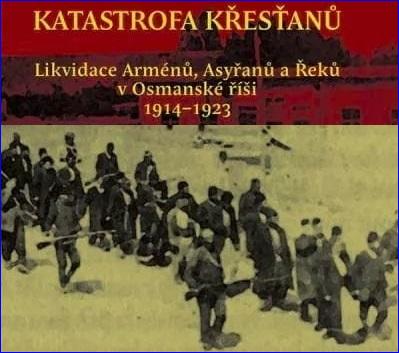


In 2017 the Czech Parliament passed a resolution recognizing the Armenian massacres and deportations that occured in the late Ottoman Empire as genocide. In a review of this book, Bohuslav Litera correctly argues that "this is not the whole truth," As the pages of this book "show that the Ottoman genocide of the Assyrians and the Greeks, which until recently remained in the shadow of the main attack on the Armenians."
The authors successfully approached the systematic mass killings and deportations from a holistic perspective, which are widely recognized as a "Christian Genocide" today, both within and outside scholarly circles.
The book is structured into four main sections, each divided in chapters. After a short introduction, section one (pp. 19-114) analyses the situation of the Christian minorities, Armenians, Assyrians and Greeks in the 19th century, up to 1914. The authors argue that "on the eve of World War I, the multi-ethnic and religiously diverse Ottoman Empire had a Christian population of 3.5 to 5 million." Within the sectarian structured Ottoman millet system, which included Armenians and Assyrians.
Related: The Assyrian Genocide
The historical phase and its impact on the non-muslim population based on the Tanzimat reforms, the developments during the reign of Abdulhamid II, and the Young Turk's revolution of 1908, which was followed by the restoration of the Ottoman Constitution.
With respect to Assyrians, the authors shed light on the denominational mosaic of the Assyrians in Anatolia and Persia. This takes account the western missions impact among Assyrians and the beginnings of an ethno-religious identity discourse. Persecution, expulsion and massacres of Assyrians, which the authors cover until 1914, illustrate the continuity of Assyrian suffering and long trail of the great catastrophe.
The core of the book is focused on the systematic liquidation of the Christian population between 1914-1923. A comprehensive history of the Armenian Genocide is given, starting with the establishment of the Special Organization, which managed and organized the deportations during the genocide, followed by a chronological treatment of the key events associated with the history of the Armenian genocide --e.g., Van uprising April-May 1915, liquidation of the Armenian male population, deportations -- and the Law on the Deportation. The events are outlined with specific treatment vilayet by vilayet and regions even outside eastern Anatolia, such as Ankara and Aleppo. The authors address the suffering of women and children during the deportations and discuss the situation of orphans, orphanages, and humanitarian organizations coping with the survivors. This chapter concludes with contemporary world public opinion on the Armenian Genocide.
A chapter is devoted to the Assyrian genocide. The authors describe what they call "a geography of horror", massacres conducted on the Assyrian population stretching from northern Mesopotamia (Diyarbekir, Mardin, Siirt, Tur Abdin) to the Hakkari Mountains and Persian Azerbaijan (Urmia, Salmas and surroundings). The book delves into key centers of successful resistance in Midyat, Ajn Wardo and Azak. The chapter closes with an outline of the assassination of the Patriarch of the Assyrian Church of the East, Már Shimun Benjamin, and the situation in 1918.
The authors state in their introduction that they consider the issue of the liquidation of Christians at the end of the Ottoman Empire "as a cognitive rather than a political one." They argue that the current desperate situation of Christians in the Middle East, which can be seen to some extent as a continuation of the destruction of these ancient communities in the places where they have lived for centuries, adds relevance to the issue.
In his review, Bohuslav Litera states "It is a brilliant example of how informal collaboration of knowledgeable authors from several different fields can lead to positive results: religious scholar/ethnographer (Mgr. M. Rutil), ethnographer/historian (Dr. P. Koštálová, Ph.D.) and historian/political scientist ( Dr. P. Novák, Ph.D.). I believe that it would be good to propose the mentioned work for an award and to translate it into a foreign language. It would greatly deserve not to remain limited only to the Czech-Slovak language area."

or register to post a comment.